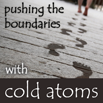Speaker
Dr
Daniel Cocks
(Goethe University Frankfurt)
Description
We investigate effects of interactions and trapping in a
cold-gas realization of a 2D time-reversal invariant
topological insulator. In contrast to solid-state systems,
the effects of trapping and the relatively small scale of
cold-gas systems can significantly effect the edge states of
topological systems. By choosing explicit realizations of
the Hofstadter lattice with various applied trapping
potentials, we show that the important properties of the
topological invariants remained unaffected, despite
seemingly unfavorable conditions. Furthermore, one can
observe a number of other features, at least in theoretical
calculations, such as splitting and merging of edge states,
along with connections between edges states and bulk bands.
These connections also reveal themselves in light-Bragg
spectroscopy, which we have used to demonstrate the
possibility for observation of edge states in these systems.
To investigate interaction effects, we have taken the
proposal of the system by Goldman et al. (PRL 105, 255302,
2010) which exhibits topologically insulating phases in an
optical square lattice using both real-space dynamical
mean-field theory (R-DMFT) and analytical techniques. This
system includes a time-invariant flux term, which emulates a
spin-dependent magnetic field similar to the
Hofstadter-lattice, a Rashba/Dresselhaus-like spin-orbit term,
which introduces non-Abelian behavior, and a staggered
super-lattice potential, which introduces non-trivial
topology at half-filling. We investigate with R-DMFT the
robustness of the topological phases for weak interaction,
as well as transitions to magnetic order at strong
interaction. We demonstrate that a critical dependence
exists dependent on the number of Dirac points. Furthermore,
we derive and analyze the corresponding
spin-Hamiltonian, and show that the competing terms of flux
and Rashba-like spin-orbit couplings produce non-trivial
spiral-like orders.
Author
Dr
Daniel Cocks
(Goethe University Frankfurt)

